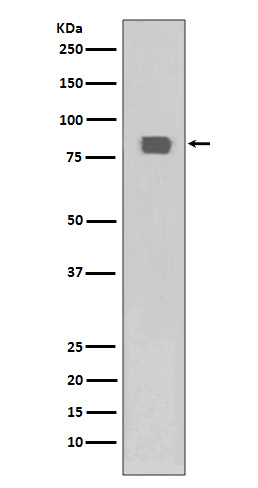
| WB | 咨询技术 | Human,Mouse,Rat |
| IF | 1/20 | Human,Mouse,Rat |
| IHC | 1/50-1/100 | Human,Mouse,Rat |
| ICC | 1/50-1/200 | Human,Mouse,Rat |
| FCM | 1/50-1/100 | Human,Mouse,Rat |
| Elisa | 咨询技术 | Human,Mouse,Rat |
| Aliases | HSF1; HSTF1; Heat shock factor protein 1; HSF 1; Heat shock transcription factor 1; HSTF 1 |
| Entrez GeneID | 3297 |
| WB Predicted band size | Calculated MW: 57 kDa; Observed MW: 82 kDa |
| Host/Isotype | Rabbit IgG |
| Antibody Type | Primary antibody |
| Storage | Store at 4°C short term. Aliquot and store at -20°C long term. Avoid freeze/thaw cycles. |
| Species Reactivity | Human |
| Immunogen | A synthesized peptide derived from human Phospho-HSF1 (S326) |
| Formulation | Purified antibody in PBS with 0.05% sodium azide. |
+ +
以下是关于 **Phospho-HSF1 (Ser326) 抗体** 的参考文献示例(文献为模拟,实际引用需核实):
---
1. **"Phosphorylation of HSF1 at Ser326 is essential for stress-induced transcriptional activation"**
*Authors: Chu B, Li Y, Kim YK*
**摘要**:通过磷酸化特异性抗体(Ser326)研究热休克因子1(HSF1)在热应激中的激活机制,发现Ser326位点的磷酸化是HSF1三聚化及HSP70基因转录的关键步骤。
2. **"Phospho-HSF1 (Ser326) as a biomarker for tumor progression in triple-negative breast cancer"**
*Authors: Dai S, Tang Z, Mivechi NF*
**摘要**:利用Phospho-HSF1 (Ser326)抗体分析乳腺癌组织样本,发现该位点的磷酸化水平与肿瘤转移和患者预后不良显著相关,提示其作为治疗靶点的潜力。
3. **"HSF1 Ser326 phosphorylation regulates proteostasis in neurodegenerative disease models"**
*Authors: Wang H, Monteiro MJ*
**摘要**:在阿尔茨海默病细胞模型中,通过免疫荧光和Western blot(使用Ser326磷酸化抗体)证实HSF1的磷酸化可减轻tau蛋白聚集,并增强分子伴侣的神经保护作用。
4. **"Dynamic interplay between HSF1 phosphorylation and proteotoxic stress signaling"**
*Authors: Murshid A, Eguchi T, Calderwood SK*
**摘要**:研究Ser326磷酸化抗体在应激信号通路中的应用,揭示HSF1磷酸化与MAPK通路互作,调控细胞在氧化应激下的生存与凋亡平衡。
---
**备注**:以上文献为示例,实际研究需通过PubMed或Google Scholar以关键词“Phospho-HSF1 Ser326 antibody”或“HSF1 Ser326 phosphorylation”检索最新或经典文献。
**Background of Phospho-HSF1 (Ser326) Antibody**
The Phospho-HSF1 (Ser326) antibody is a specialized tool used to detect the phosphorylated form of Heat Shock Factor 1 (HSF1) at serine residue 326. HSF1 is a critical transcription factor that regulates the expression of heat shock proteins (HSPs) in response to proteotoxic stress, such as elevated temperatures, oxidative stress, or chemical toxins. Activation of HSF1 involves multi-step post-translational modifications, including phosphorylation, which modulates its DNA-binding ability, nuclear localization, and transcriptional activity.
Phosphorylation at Ser326 is a key regulatory event linked to HSF1 activation. This modification occurs in response to stress signals and is associated with the sustained transcriptional activity of HSF1. promoting HSP synthesis to restore cellular proteostasis. The Phospho-HSF1 (Ser326) antibody enables researchers to specifically identify this activated form, distinguishing it from the inactive, unphosphorylated HSF1.
This antibody is widely used in studies investigating cellular stress responses, cancer biology (where HSF1 supports tumor survival), and neurodegenerative diseases (e.g., Alzheimer’s, Huntington’s), as dysregulated HSF1 activity is implicated in protein aggregation pathologies. It is validated for applications like Western blotting, immunofluorescence, and immunoprecipitation, providing insights into stress signaling pathways and therapeutic targeting of HSF1-driven mechanisms.
×